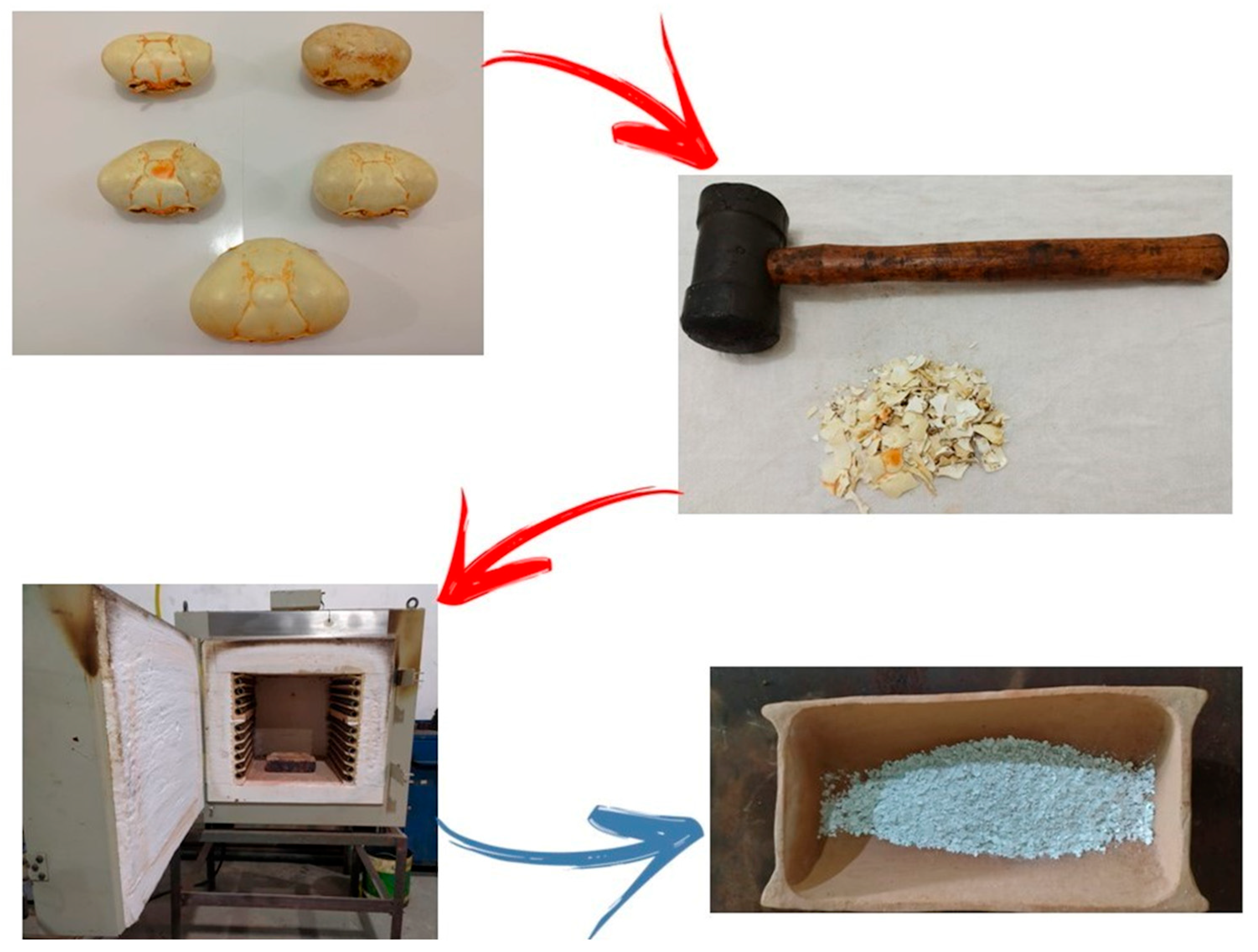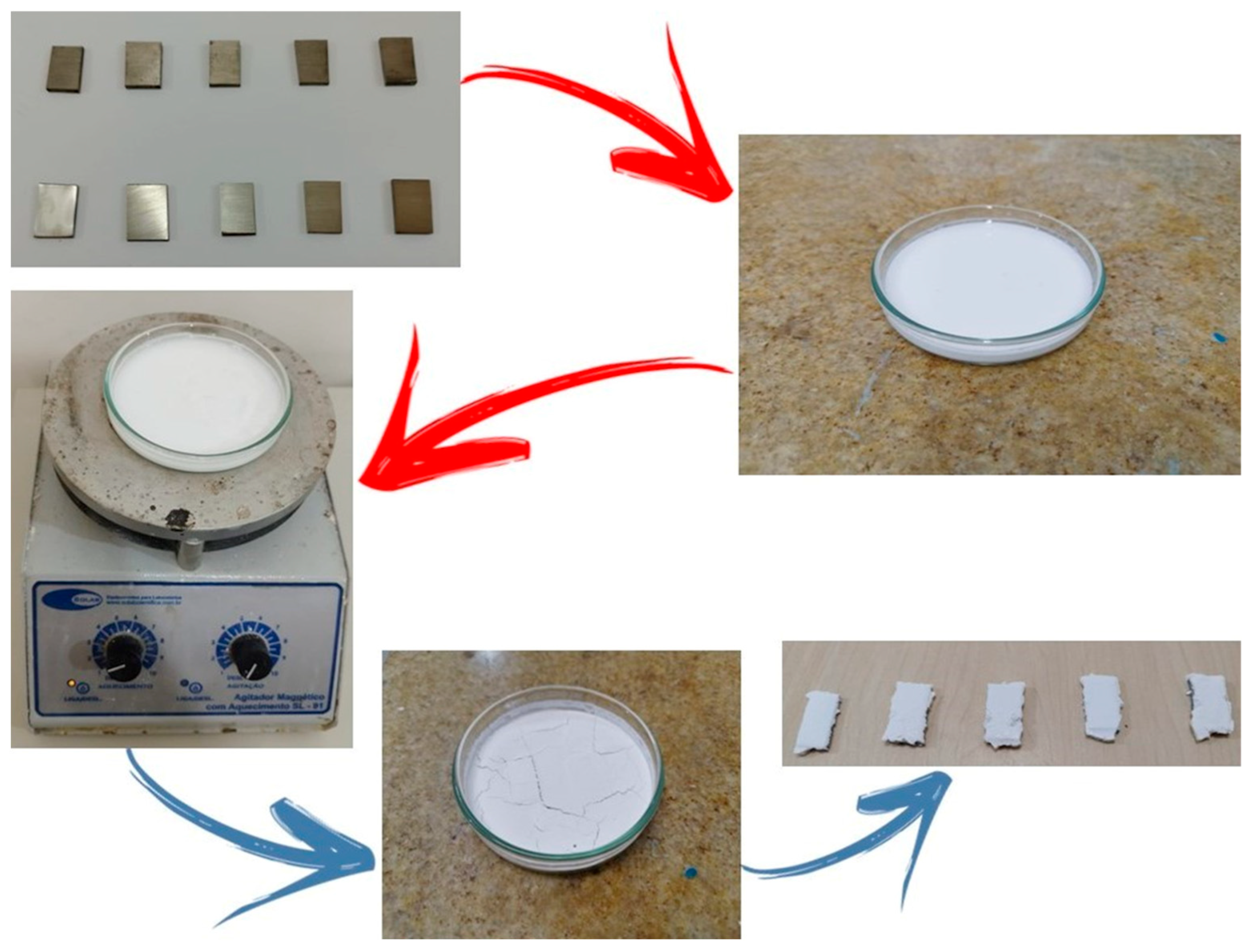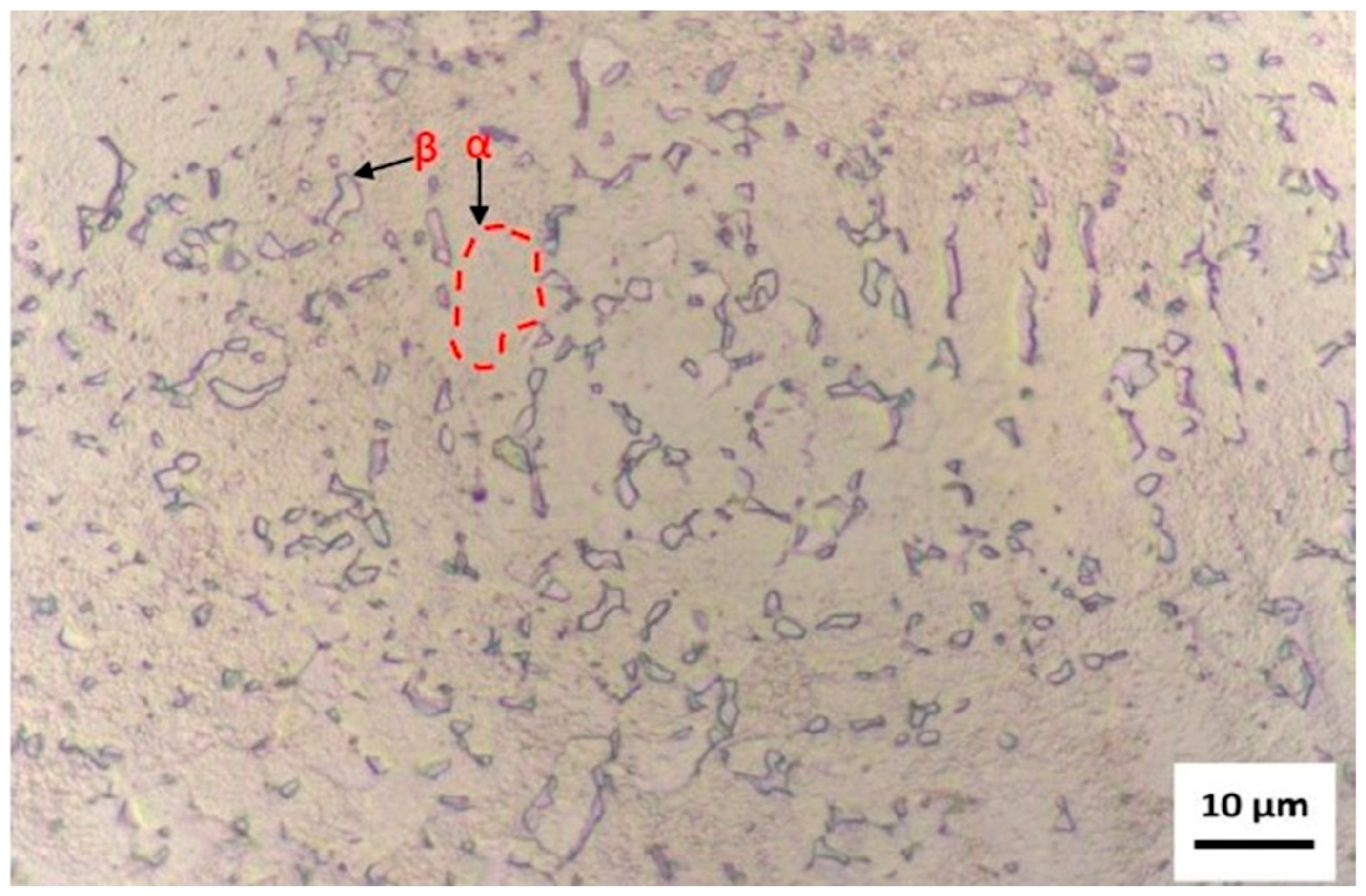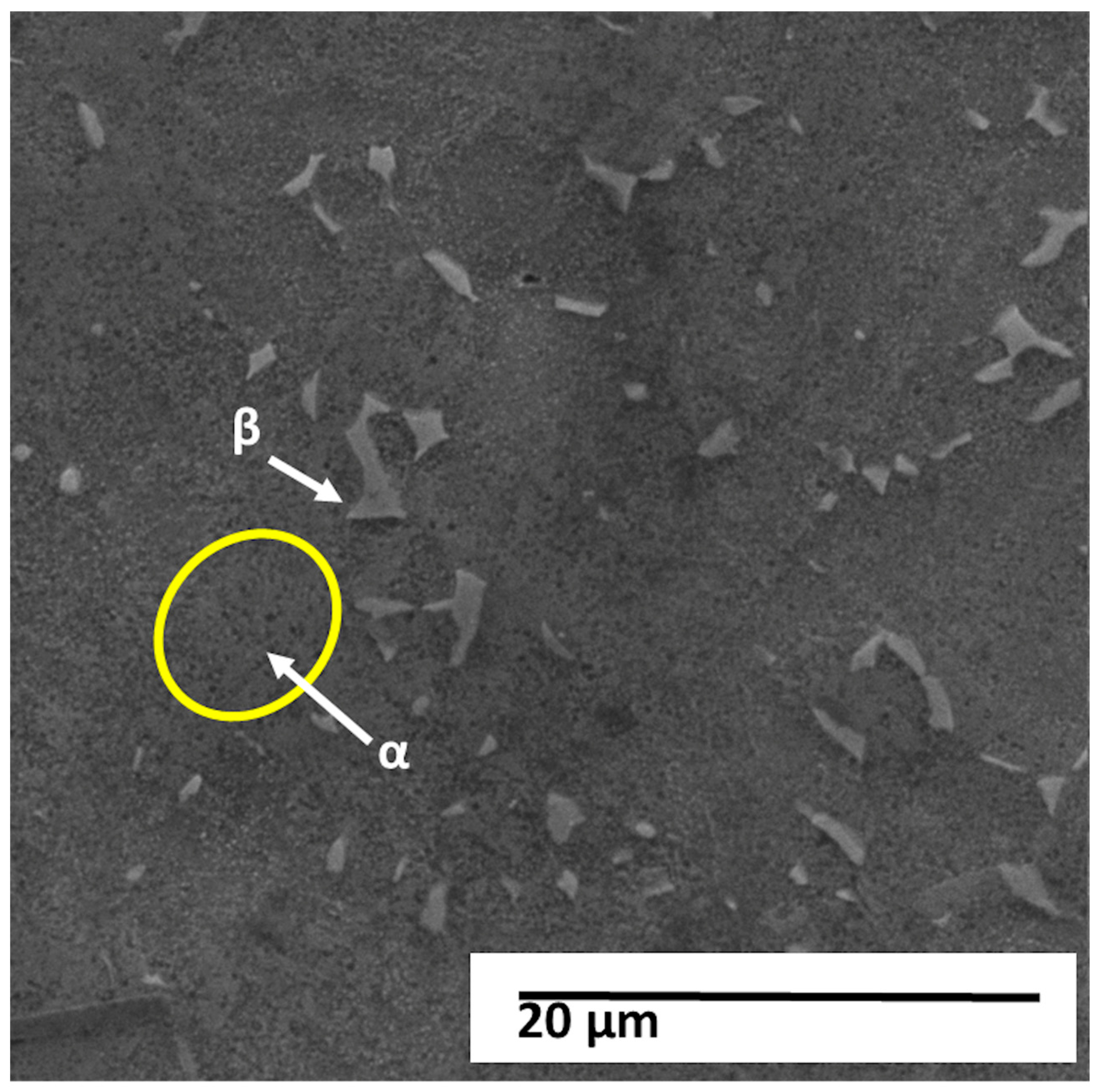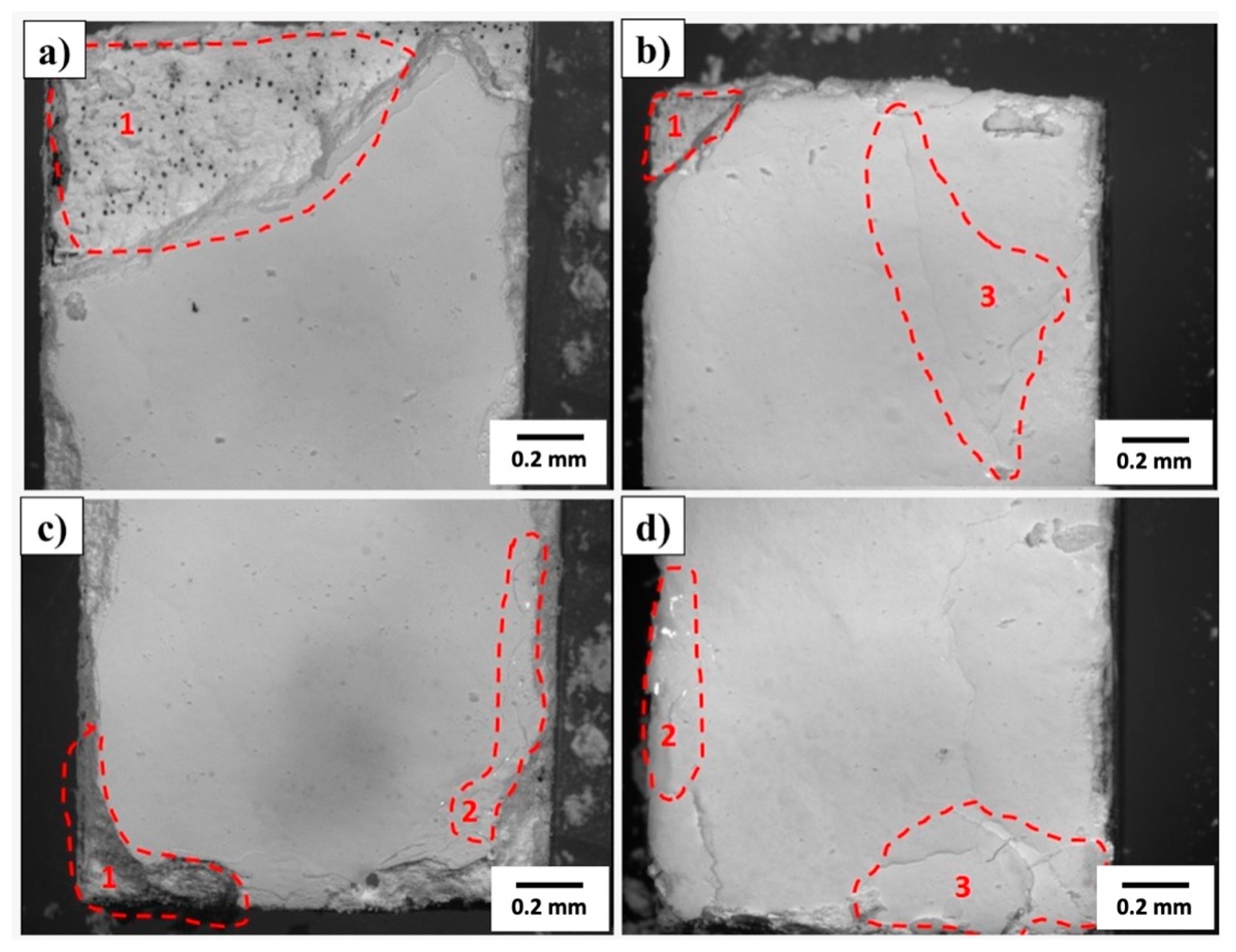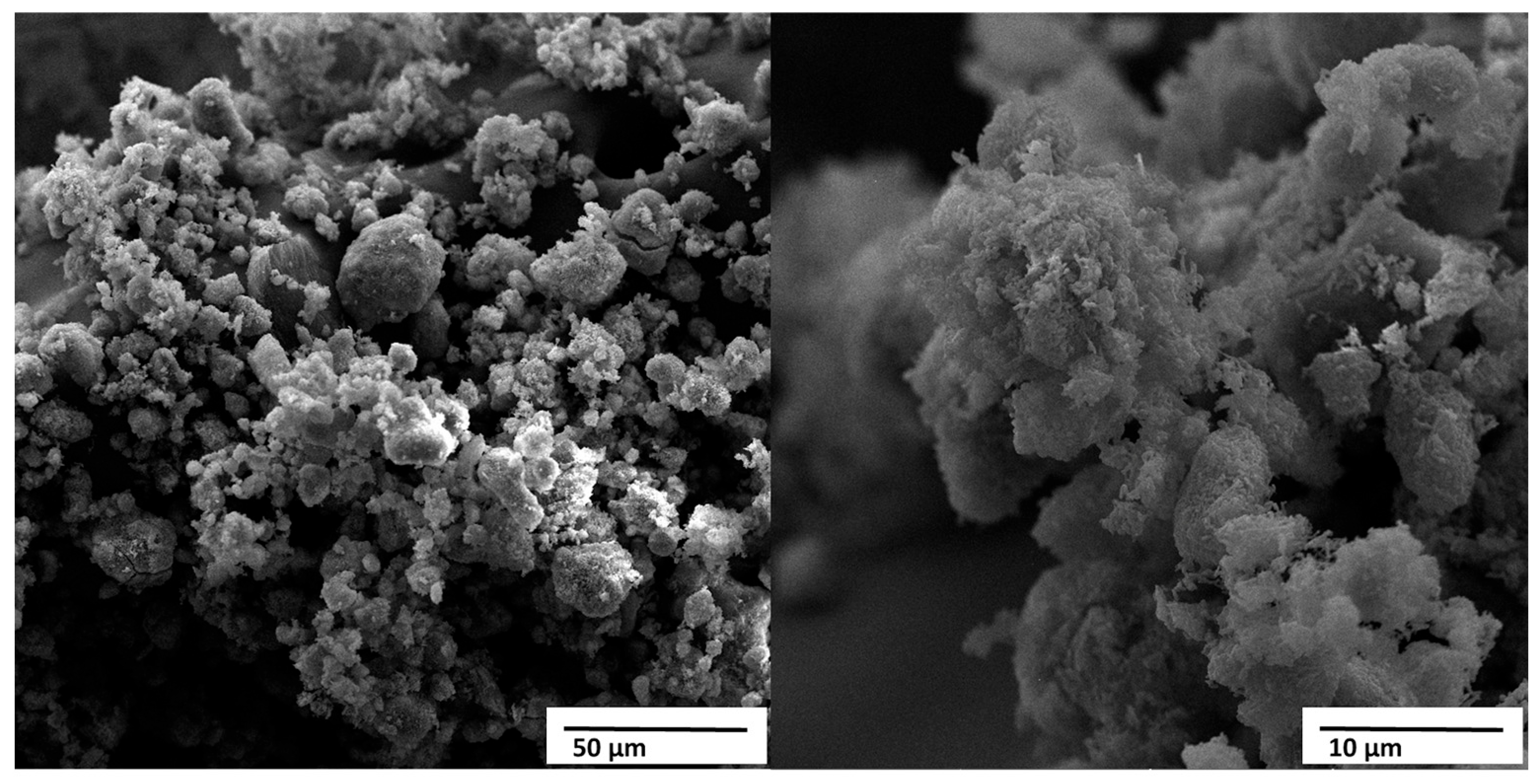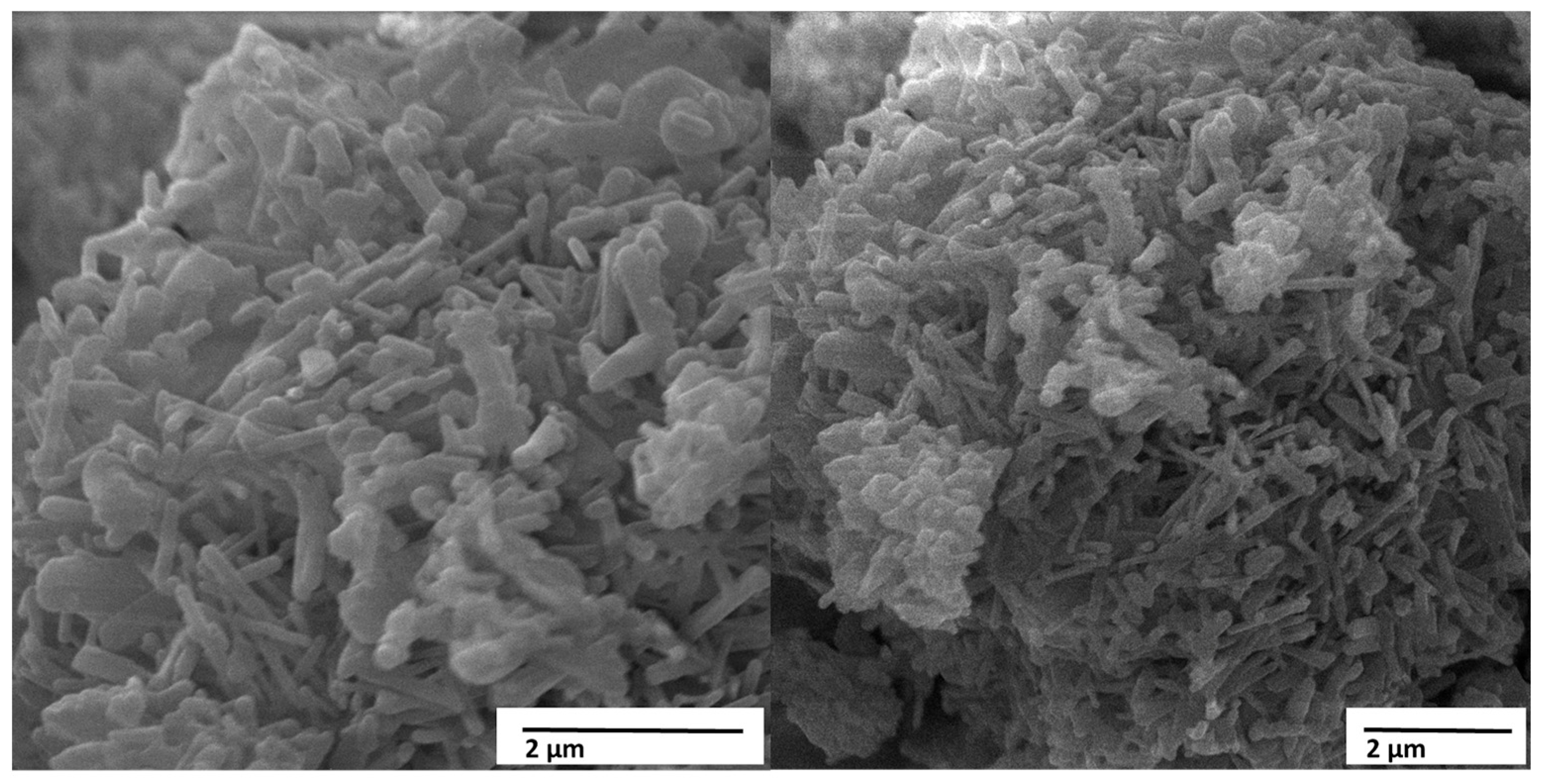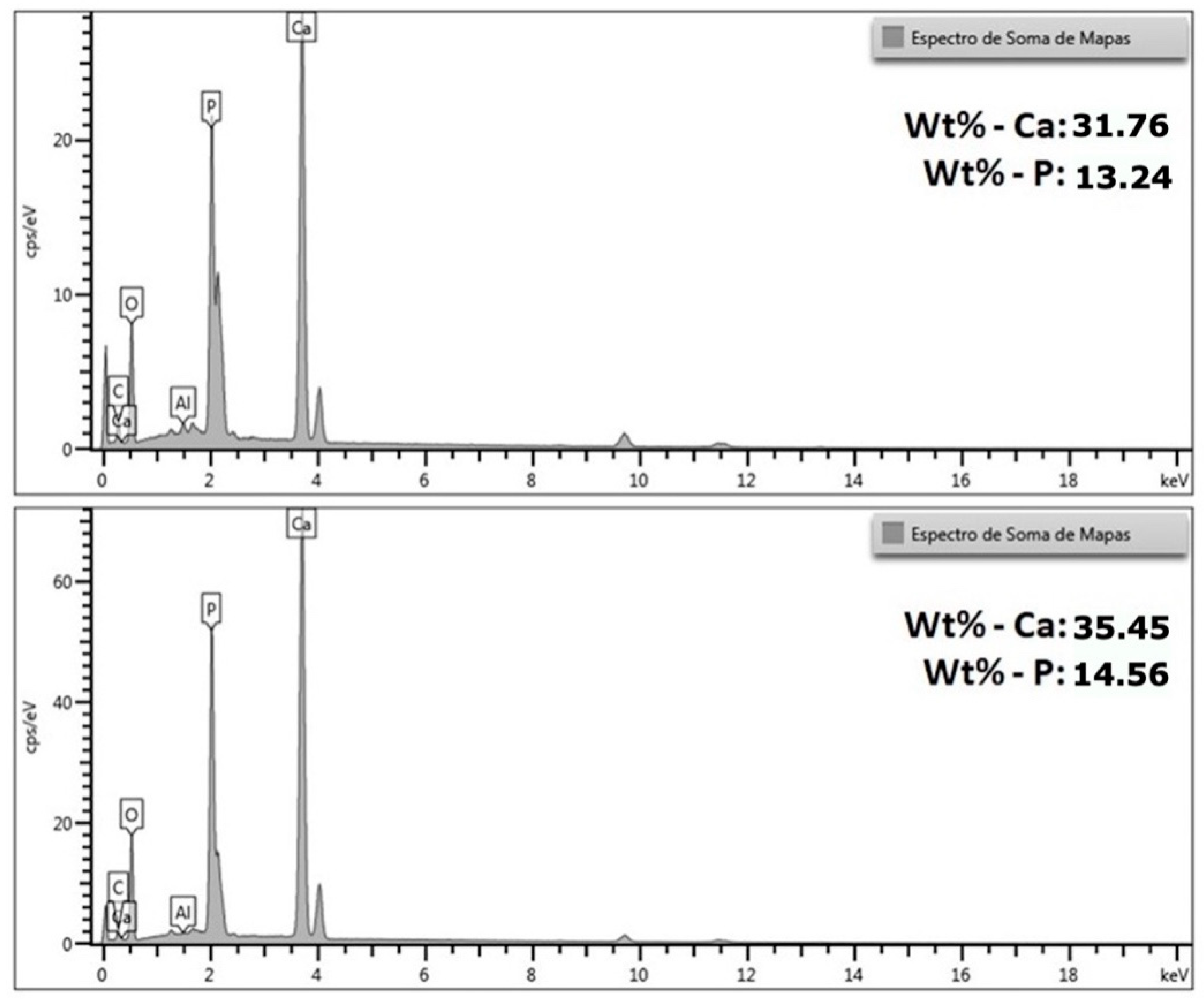3.1. Characterization of Metallic Material
3.1.1. Chemical Composition
Table 1 presents a comparison between the chemical composition of the titanium substrates used in this study and the values specified for the commercial Ti-6Al-4V alloy according to the ASTM F136-18 [
28].
Based on the average results obtained by optical emission spectrometry (OES), the analyzed samples contained 88.75 wt.% Ti, 7.46 wt.% Al, and 3.41 wt.% V. When compared to the standardized composition range (Al = 5.5–6.5 wt.%; V = 3.5–4.5 wt.%; Ti = balance), these results reveal a deviation from the typical Ti-6Al-4V alloy. The aluminum content exceeds the upper limit specified by the standard, while the vanadium content is slightly below the minimum value. Therefore, the alloy used in this study can be classified as a non-conforming variant of Ti-6Al-4V and should be referred to as a Ti-Al-V alloy outside the ASTM F136-18 [
28].
These compositional deviations have direct implications for the alloy’s microstructure and mechanical behavior. The excess aluminum, an α-phase stabilizer, combined with the slight deficiency of vanadium, a β-phase stabilizer, indicates a tendency toward a higher fraction of the α phase and a corresponding reduction in the β phase at room temperature. This shift may lead to an alloy exhibiting a slightly higher elastic modulus and strength, but with reduced ductility and toughness, as well as an increase in the β-transus temperature.
In the context of HA deposition, such compositional differences may influence the surface chemistry of the substrate. The higher aluminum content promotes the formation of aluminum oxides (Al2O3) rather than vanadium oxides, thereby modifying surface energy, wettability, and local charge distribution—factors that can affect the nucleation and adhesion behavior of the HA coating.
The observed deviations may arise from several factors, including the use of a titanium alloy batch that does not fully comply with Ti-6Al-4V specifications, surface segregation phenomena (alpha-case) induced by thermal oxidation or processing, or analytical uncertainties inherent to the OES method, such as matrix calibration, burn depth, and argon purity during purging.
Thus, the critical assessment of the results indicates that the metallic substrates employed in this study do not fully correspond to the standardized Ti-6Al-4V alloy but rather to a compositional variation of it. This distinction must be considered in the interpretation of microstructural and mechanical results, as well as in the evaluation of the interfacial behavior between the titanium substrate and the deposited HA layer.
Therefore, throughout the manuscript we refer to the substrate as a Ti–Al–V α + β alloy outside the ASTM F136-18 [
28] limits, while noting that its hardness and microstructure remain typical of α-rich Ti–6Al–4V-like materials.
3.1.2. Optical Microscopy
Figure 3 shows the micrograph of the titanium alloy studied, obtained by optical microscopy at 200× magnification after chemical etching by immersion in Kroll’s reagent for 80 s.
The observed morphology reveals a typical α + β titanium alloy microstructure, although certain features suggest a chemical composition slightly outside the standard range of Ti-6Al-4V, as previously discussed. The image displays a matrix predominantly composed of the α phase (hexagonal close-packed), visible as light, elongated, and acicular regions, interspersed with thin, dark areas corresponding to the β phase (body-centered cubic). This structural arrangement is characteristic of α + β alloys air-cooled from the β region, indicating solidification and subsequent heat treatment without controlled aging.
The irregular distribution and fine lamellar morphology of α within the β matrix suggest an intermediate cooling rate, consistent with hot-worked alloys cooled in air, with no evidence of martensitic α′ formation. The absence of well-defined α colonies and the presence of fine, dispersed lamellae can be attributed to the higher aluminum content (7.46 wt.%) identified in the chemical analysis, which acts as an α-phase stabilizer, raising the β-transus temperature and promoting microstructural refinement. Conversely, the slightly lower vanadium content (3.41 wt.%), a β-phase stabilizer, contributes to a reduction in the β phase fraction, supporting the predominance of α observed in the micrograph.
The contrast achieved through Kroll’s reagent etching clearly delineates the α grain boundaries and the interlamellar β phase, confirming a typical α + β morphology with a dominant α phase. This microstructural configuration generally results in higher mechanical strength and elastic modulus, albeit at the expense of ductility and fracture toughness, as expected for aluminum-enriched α + β titanium alloys.
Overall, the micrograph confirms that the material retains the α + β morphology characteristic of Ti-Al-V alloys, but with a strong tendency toward α-phase stabilization, consistent with the chemical composition deviations identified by spectrometric analysis. This predominance of the α phase may directly influence the surface behavior during HA deposition, since the topography and oxide chemistry are strongly dependent on the crystallographic nature of the exposed phase.
Figure 4 presents the micrograph of the titanium alloy studied, obtained by optical microscopy at 1000× magnification after chemical etching in Kroll’s reagent for 80 s, followed by image enhancement for phase distinction.
The microstructure reveals a dual-phase morphology (α + β) typical of titanium alloys with compositions near Ti-6Al-4V; however, the relative phase proportions and morphology indicate a predominance of the α phase, consistent with the chemical analysis results, which identified an aluminum content above and a vanadium content slightly below the ASTM F136-18 [
28] specification limits.
The α phase (hexagonal close-packed) appears as elongated or equiaxed light regions, while the β phase (body-centered cubic) is observed as dark intergranular regions, often forming thin, discontinuous networks. This phase distribution suggests a non-homogeneous transformation from β to α during cooling, indicative of an intermediate cooling rate typical of air-cooled or furnace-cooled samples after hot working. The discontinuous nature of the β boundaries and the fine dispersion of α grains point to a microstructure refined by the higher aluminum content (7.46 wt.%), which increases the β-transus temperature and promotes α-phase stabilization.
The volume fraction of the β phase appears reduced, which corroborates the slightly lower vanadium content (3.41 wt.%) found in the chemical composition analysis. Vanadium is a β-stabilizing element; therefore, its deficiency results in a microstructure biased toward α-phase dominance. The grain morphology also indicates a lamellar α within prior β grains, characteristic of a Widmanstätten or basket-weave microstructure, which often forms when the alloy is cooled moderately from the β region. Such a microstructure tends to enhance strength and hardness, but may reduce ductility and fracture toughness—a balance consistent with the mechanical performance typically observed in α-rich titanium alloys.
The contrast obtained through Kroll’s reagent effectively delineates the grain boundaries and interphase regions, allowing clear visualization of the α/β interfaces. The uniform etching response and the absence of secondary precipitates suggest a homogeneous distribution of alloying elements, though local differences in contrast might also indicate slight chemical segregation at α/β interfaces or incipient oxidation from surface exposure prior to etching.
From a metallurgical perspective, this α-dominant α + β microstructure reflects the compositional deviations previously identified and confirms that the alloy, while closely resembling Ti-6Al-4V, corresponds to a non-standard Ti-Al-V composition with a greater α-phase stability. This microstructural configuration can influence the surface reactivity and oxide formation behavior during subsequent processing, particularly affecting HA nucleation and coating adhesion, as the α phase tends to form more stable TiO2 and Al2O3 oxides, altering surface charge and energy.
3.1.3. Scanning Electron Microscopy (SEM) and X-Ray Dispersive Spectroscopy (EDS)
Figure 5 shows the micrograph obtained by scanning electron microscopy (SEM) with a magnification of 5000×, working distance (WD) of approximately 15.0 mm, accelerating voltage of 20 kV, and combined detection by secondary (SE) and backscattered electrons (BSE).
The image shows the surface of the titanium alloy under study, revealing a two-phase (α + β) microstructure with smooth surface relief and the presence of discontinuous, finely distributed lamellae with micrometer dimensions. The highlighted regions indicate the typical α and β phases of this alloy.
In secondary electron images, the darker, recessed regions generally correspond to the β phase (vanadium-enriched and body-centered cubic—BCC) while the lighter, more prominent regions represent the α phase (aluminum-stabilized and hexagonally close-packed—HC). The observed contrast is predominantly topographic, resulting from chemical attack and the difference in corrosion rates between the phases. The presence of short, fragmented, and slightly continuous β lamellae embedded in an α matrix reinforces the characteristic of a Widmanstätten (or “wicker basket”) microstructure, formed at intermediate cooling rates, typical of air cooling after hot processing.
The fine dispersion of the α phase and the discontinuity of the β phase are consistent with a chemical composition outside the typical range of the Ti-6Al-4V alloy, as previously identified. The higher aluminum content (7.46%) acts as a stabilizer of the α phase, raising the β transition temperature (β-transus) and promoting microstructural refinement. On the other hand, the lower vanadium content (3.41%), a stabilizer of the β phase, reduces the volume fraction of the β phase, resulting in a predominantly α matrix, which explains the appearance observed in the image.
The absence of α′ martensite and the presence of refined α lamellae indicate that cooling was not rapid enough to generate martensite, but also not slow enough to allow the growth of coarse colonies—typical behavior of hot-worked and air-cooled materials. Small pits and polishing flaws observed on the surface suggest artifacts of metallographic preparation, while isolated bright spots can be attributed to contamination residues or reprecipitation of material during etching or conductive coating.
The observed α-dominant microstructure tends to exhibit higher elastic modulus and mechanical strength, although with lower ductility and fracture toughness, compared to more β-rich alloys. This configuration is consistent with the measured chemical composition, confirming that the analyzed material is a Ti-Al-V alloy outside the ASTM F136-18 [
28] specifications.
From a functional perspective, the predominance of the α phase directly influences the surface behavior of the material, especially regarding oxide formation. α surfaces tend to form more stable layers of TiO2 and Al2O3, which can alter the surface energy, wettability, and local electrical charge, affecting the nucleation and adhesion of the HA layer. The high density of α/β interfaces can, on the other hand, favor the heterogeneous nucleation of HA due to the increased number of active sites and crystalline defects.
A more detailed view of the same region, shown in
Figure 6, reveals the fine lamellar arrangement of α and β phases and identifies the EDS points selected for local compositional analysis.
Figure 6 shows the micrograph obtained by scanning electron microscopy (SEM), with a magnification of 10,000× and an acceleration voltage of 20 kV, in which three points of punctual analysis by energy dispersive X-ray spectroscopy (EDS) were identified, called P1, P2 and P3.
The spectra obtained reveal significant differences in the concentrations of aluminum (Al) and vanadium (V), reflecting the chemical heterogeneity typical of two-phase titanium alloys. At point P1, an Al content of 4.31% and V of 1.96% were observed, while at points P2 and P3 the measured values were, respectively, Al = 3.04%; V = 8.03% and Al = 2.87%; V = 10.57%.
This local compositional variation is consistent with the partitioning behavior of alloying elements between the α (hexagonal close-packed) and β (body-centered cubic) phases in Ti-Al-V alloys. Point P1, which has a higher aluminum concentration and lower vanadium content, can be associated with the α phase, stabilized by Al. Points P2 and P3, with higher vanadium and lower aluminum contents, are characteristic of the β phase, stabilized by V. Thus, the EDS results corroborate the presence of an α + β microstructure, in which there is a predominance of the α phase and discontinuous regions of β, in agreement with the previous micrographs and with the global chemical analysis obtained by optical emission spectrometry (OES).
The average chemical composition obtained by OES (Al = 7.46%; V = 3.41%) indicated an alloy outside the Ti-6Al-4V composition range standardized by ASTM F136-18 [
28], presenting excess Al and V deficiency. The specific EDS results, therefore, confirm the expected partitioning: regions with local Al enrichment associated with the α phase and V-enriched regions corresponding to the β phase. This microchemical heterogeneity is typical of α + β alloys and explains the differences between local measurements and the average material composition, since EDS evaluates micrometric volumes and integrates information from different lamellae and interfaces.
Secondary Si and Fe peaks were also observed in the spectra, likely resulting from surface contamination from the metallographic preparation process, such as silica-based abrasive residues, cutting disc particles, or metal fragments from equipment. These elements appear in very low concentrations and do not indicate the presence of significant intermetallic phases.
Morphological analysis, combined with EDS data, reinforces the conclusion that the material exhibits a refined Widmanstätten microstructure, consisting of finely distributed α lamellae and discontinuous β regions, characteristic of intermediate cooling after thermomechanical processing. This configuration results from a higher Al content, which raises the β transition temperature (β-transus) and promotes a higher α-phase fraction, and a lower V content, which reduces β-phase stability.
From a material properties perspective, the predominance of the α phase tends to provide higher elastic modulus and mechanical strength, but lower ductility and fracture toughness, compared to alloys with a higher β fraction. This characteristic should be considered when interpreting mechanical tests and analyzing surface behavior during the HA deposition process. Local differences in the distribution of the α and β phases also affect oxide layer formation, influencing wettability, surface energy, and surface electrical charge, which can modify HA nucleation and adhesion.
3.1.4. Hardness
Figure 7 shows the indentations obtained during the Rockwell hardness test, in which ten indentations were made per sample, arranged in a centerline and at random positions, to determine the average hardness of the material representatively, without concentrating the measurements on specific regions. For clarity, the individual Rockwell C hardness values obtained at each test point have been added directly to
Figure 7, positioned adjacent to the corresponding indentations. This experimental strategy is appropriate for α + β titanium alloys, whose microstructure presents intrinsic heterogeneity due to the simultaneous presence of α lamellae and β regions, preventing the reading from being influenced by local phase variations.
The image shows that the indentations are well-defined and distributed throughout the sample, indicating a uniform test. However, sanding marks and residual surface scratches are noticeable, suggesting that the surface finish could be improved to reduce roughness and, consequently, minimize reading errors. Excessively rough or poorly polished surfaces can cause artificial variations in the measurement, as the indenter may impact micro-elevations or depressions, generating slightly higher or lower hardness values than the actual ones. Therefore, it is recommended that sample preparation include fine sanding (up to 1200 grit) followed by light polishing, ensuring homogeneity and the absence of metal debris under the indenter.
Table 2 presents the average Rockwell C hardness (HRC) values obtained for samples A1 and A2 of the studied titanium alloy, as well as the reference values available in the ASM Handbook, Volume 2 [
29], for the Ti-6Al-4V alloy in as-supplied condition.
The hardness measurements obtained for the Ti–Al–V alloy showed good consistency between samples and fell within the range expected for Ti–6Al–4V–type alloys in the as-received condition. Both specimens exhibited low variability between indentations, indicating microstructural uniformity at the local scale. The values are also compatible with an α-rich α + β microstructure, as observed in the metallographic analysis, which typically leads to hardness values slightly above those of alloys with higher β content. These findings confirm that, although the chemical composition deviates slightly from ASTM F136-18 [
28] limits, the mechanical response remains characteristic of conventional Ti–6Al–4V alloys.
Statistical analysis shows that both samples presented low dispersion of results, with standard deviations of 0.499 HRC for A1 and 0.923 HRC for A2, and corresponding standard errors of 0.157 HRC and 0.292 HRC, respectively. Sample A2 presented slightly greater variation, which may be associated with the microstructural heterogeneity observed in the metallographic analyses, since small local differences in the fraction of α and β phases can affect the response to the hardness test. Furthermore, subtle differences in surface preparation, effective sample thickness, or the distance between indentations may also have contributed to the greater variability observed in A2.
Considering the 95% confidence interval, the means obtained for A1 (35.07 ± 0.31 HRC) and A2 (35.83 ± 0.57 HRC) overlap the range established by ASM, confirming that the measured values are statistically compatible with the expected range for Ti-6Al-4V alloys. The difference between the means of the two samples (0.76 HRC) is small and, although statistically detectable, does not represent a practically significant difference. This variation can be attributed to small local fluctuations in the microstructure—regions richer in the α phase, stabilized by aluminum, tend to present greater hardness, while areas with a higher fraction of the β phase, stabilized by vanadium, exhibit slightly lower values.
The hardness results are consistent with the microstructural and chemical characterization discussed previously. The micrograph showed an α + β structure with a predominance of α, which is consistent with the presence of a higher aluminum and lower vanadium content compared to the standard Ti-6Al-4V alloy. This microstructural configuration tends to slightly increase the hardness and elastic modulus of the material, although it may reduce its ductility and fracture toughness. Thus, the hardness values obtained confirm the expected mechanical behavior for an α-dominant Ti-Al-V alloy, corroborating the conclusions drawn from the metallographic and chemical analyses.
Table 3 shows the arithmetic roughness averages (Ra) measured in triplicate on untreated surfaces (ST) and on surfaces subjected to sanding + thermochemical treatment (CT).
The untreated surfaces (ST) showed a markedly heterogeneous roughness profile, suggesting significant variability in the starting surface condition, likely stemming from prior machining marks and oxidation differences. In contrast, the treated surfaces (CT) exhibited a highly uniform roughness, indicating that the thermochemical protocol not only reduced variability but also standardized the surface topography. This homogenization is beneficial for coating processes, as more uniform surfaces tend to promote consistent HA nucleation and adhesion. Additionally, the slight decrease in mean Ra after treatment suggests improved wettability and surface reactivity, which align with the enhanced coating uniformity observed in later analyses.
The intra-sample standard deviations (“D. Standard” lines) are low in both groups (typically 0.008–0.059 µm in ST and 0.010–0.017 µm in CT), indicating good profilometer repeatability in the same region. However, the inter-sample variability is clearly higher in ST (due to the wide range of means), while in CT it practically disappears (all means ~0.587 µm). The listed standard errors (S/√3) confirm the metrological consistency of the readings.
From a functional point of view, the Ra range of ~0.55–0.60 μm obtained after the treatment is suitable for HA nucleation and adhesion, as several studies report that surface roughness values between approximately 0.2 and 1.5 μm promote ion adsorption, early-stage nucleation, and improved bonding of Ca–P phases on titanium substrates [
3,
6]. It is also noted that the treatment acted as a “normalizer”: on very smooth surfaces (e.g., A4–ST = 0.416 µm), Ra increased to ~0.587 µm; on very rough surfaces (e.g., A2–ST = 0.954 µm), Ra decreased to the same level. This convergence tends to standardize surface energy and wettability, favoring more homogeneous coatings.
The thermochemical treatment not only homogenized the roughness but also modified the surface chemistry through oxidation and hydroxylation, increasing surface energy and wettability. These effects favor the initial adsorption of Ca2+ and PO43− ions from the suspension and facilitate heterogeneous nucleation of HA, which explains the improved coating continuity observed later by optical and electron microscopy. The resulting Ra ≈ 0.587 µm lies within the optimal range reported for HA nucleation on titanium (0.2–1.0 µm), ensuring sufficient anchoring without compromising coating uniformity.
3.1.5. Correlation Between Substrate Features and Coating Behavior
The chemical and microstructural features of the Ti–Al–V substrate directly affect the adhesion and growth of the HA layer. The predominance of the α phase and the presence of α/β interfaces increase the density of high-energy sites and crystallographic mismatches that act as preferential nucleation points for Ca–P compounds. Likewise, the uniform hardness (~35 HRC) and fine Widmanstätten morphology provide a mechanically stable base that resists plastic deformation during coating formation and drying. These characteristics are expected to enhance interfacial bonding by combining mechanical interlocking with localized chemical reactivity. Therefore, understanding the substrate state is essential to interpret the coating morphology and the effect of thermochemical treatment discussed in the following sections.
3.2. Characterization of the Deposited HA Layer
3.2.1. Optical Microscopy
Figure 8 shows, by optical microscopy, the surface morphology of the HA layers obtained after drying the samples in a desiccator for 24 h. Quantitative surface roughness measurements were not performed after the HA deposition. However, qualitative analysis based on optical and electron micrographs indicates that the coating increased the apparent surface roughness relative to the polished titanium substrate. The formation of porous, granular, and acicular HA agglomerates produced a micro–nano hierarchical topography, visually more irregular than the underlying metal surface (Ra ≈ 0.587 µm). Therefore, although the mean Ra value after coating was not measured, it can be inferred that the overall surface roughness increased due to the intrinsic porosity and crystallite morphology of the deposited HA layer.
In all samples, complete coverage of the metal substrate is observed, with an opaque white color and a plaster-like appearance, consistent with a water-deposited ceramic film. However, detailed analysis of the images reveals the presence of local heterogeneities that deserve attention regarding the thickness, continuity, and adhesion of the deposited layer.
In specific regions of the micrographs, labeled 1, 2, and 3, material accumulates at the edges and corners of the samples, forming a thicker layer, characteristic of drying by meniscus recession, a phenomenon known as coffee-ring. This effect occurs due to the capillary migration of solid particles from the center to the edges during solvent evaporation, resulting in a thickness gradient between the center and the edges of the sample. Consequently, thicker edges tend to concentrate residual drying stresses, increasing the propensity for microcrack formation and localized spalling.
Fine cracks and shrinkage marks are also visible on the film surface, particularly in the areas labeled 3. These discontinuities are attributed to the volumetric contraction of the ceramic matrix during the drying process, typical of aqueous suspensions with a high solids fraction. This shrinkage is intensified by the differential adhesion between the film and the substrate, as surfaces with better anchoring impose greater internal traction on the film. Additionally, small gaps and isolated pores can be observed, related to the trapping of air bubbles, non-dispersed agglomerates, or particles detached during drying. Although uncommon, these defects act as stress concentrators and can serve as initiation points for mechanical failure or debonding.
Table 4 presents the thickness measurements of the HA layers deposited on the metal substrates with and without surface treatment, expressed in micrometers (µm).
In general, the average thicknesses obtained for the untreated (ST) and treated (CT) specimens are similar—95 µm and 98 µm, respectively—indicating that, in terms of overall average thickness, the thermochemical treatment did not cause a significant variation in the amount of deposited material. However, individual analysis of the samples reveals distinct behaviors and marked heterogeneity among the specimens, demonstrating that the surface treatment influenced deposition inconsistently.
In the ST group, thicknesses ranged from 80 to 129 µm, resulting in a range of 49 µm and a coefficient of variation of approximately 25%, indicating considerable dispersion among the samples. In the CT group, the variation was even more pronounced, with values between 57 and 135 µm and a range of 78 µm, corresponding to a coefficient of variation exceeding 40%. These results indicate that the thermochemical treatment did not bring uniformity to the layer thickness; on the contrary, it appears to have increased thickness variability.
Analyzing the samples individually, it is clear that the effect of the treatment was not systematic. In two of them (Samples 01 and 03), the thickness decreased after treatment, going from 90 to 57 µm and from 80 to 71 µm, respectively. In contrast, in Samples 02 and 04, the thickness increased considerably, reaching 131 µm and 135 µm, compared to 80 µm and 129 µm in the untreated samples. This random variation between increase and decrease suggests that local and procedural factors, such as wettability, surface tension, suspension rheology, and drying conditions, exerted a greater influence on the result than the chemical treatment itself.
These findings are consistent with observations made using optical microscopy (
Figure 8), which revealed the presence of material accumulations at the edges (coffee-ring effect), shrinkage microcracks, and center-to-edge thickness gradients, typical of ceramic films formed by aqueous deposition and drying. The non-uniformity in material distribution can be explained by capillary migration of solid particles during evaporation, which leads to peripheral thickening and the formation of thinner zones in the center of the sample. Furthermore, small differences in surface energy between the treated and untreated groups may have modified the wettability of the HA suspension, resulting in thinner or thicker layers, depending on the balance between spreading and adhesion.
Another important aspect is the possible influence of the measurement point. If measurements were taken in different regions (edge, center, or intermediate areas), it is natural that the differences will be accentuated, especially in films with a thickness gradient. Thus, the observed variability may reflect not only the actual morphology of the film, but also local variations in the measurement methodology.
Overall, the heterogeneous layer thicknesses observed in both groups can be interpreted by considering surface energy and liquid-film dynamics during drying. Treated samples, despite exhibiting similar mean Ra values, have higher surface polarity due to the formation of TiO2 and Al2O3–OH groups. This chemical activation promotes stronger local adhesion but also induces differential capillary flows during solvent evaporation, leading to peripheral thickening (coffee-ring effect) and microcracking. Hence, the surface treatment improves wetting and adhesion at the expense of slightly higher morphological heterogeneity.
Although no direct mechanical testing of the HA coating was performed, qualitative observations indicate that the deposited layer exhibited good adherence and cohesion. The coating remained firmly attached to the Ti–Al–V substrate during handling, sectioning, and polishing for cross-sectional microscopy, showing no signs of delamination or detachment. This behavior suggests sufficient interfacial bonding for laboratory-scale evaluation. However, the mechanical strength and long-term durability of the coating under physiological or mechanical stress conditions were not quantified in this study. Future work will include adhesion tests (e.g., scratch or pull-off methods) and immersion durability assessments in simulated body fluid (SBF) to evaluate the coating’s mechanical stability and its evolution over time. Such analyses will be essential to confirm the practical applicability of the biogenic HA layer for biomedical use.
It should be noted that quantitative adhesion testing was not performed in this study. Only qualitative assessment was conducted during handling, cross-sectioning, and polishing, where the HA layer remained attached to the substrate without signs of delamination. Although this confirms adequate cohesion for laboratory-scale manipulation, it does not substitute for standardized mechanical adhesion tests. ISO 13779-2:2018 [
30] establishes that HA coatings intended for high biomechanical loads must exhibit tensile bond strength values ≥15 MPa. Future work will therefore include quantitative adhesion measurements (e.g., pull-off or scratch testing) to determine compliance with ISO requirements and to more rigorously assess the coating’s suitability for biomedical implant applications.
3.2.2. X-Ray Fluorescence (XRF)
Although the XRD pattern of the calcined precursor was not obtained, XRF analysis was performed to confirm the presence of calcium oxide as the major constituent. As shown in
Table 5, CaO is the predominant oxide, followed by P
2O
5, with only trace contributions from other oxides such as SrO and K
2O. This composition indicates that the material is markedly calcium-rich, a characteristic frequently observed in apatites derived from marine sources.
The Ca-enriched profile implies that the conversion of CaCO3 → CaO → HA was not fully stoichiometric, and that a fraction of CaO or Ca(OH)2 likely remained unreacted during wet-chemical synthesis. This effect is expected in low-temperature routes where diffusion and reaction kinetics limit complete phase transformation. Consequently, the calculated Ca/P ratio derived from the oxide proportions is higher than the stoichiometric value of HA (1.67), suggesting the coexistence of secondary Ca-based phases rather than a single-phase apatitic material.
From a functional perspective, such Ca-rich compositions may increase initial alkalinity, solubility, and ionic release—parameters that typically accelerate early-stage bioactivity and the formation of secondary apatite in physiological media. However, excessive CaO/Ca(OH)2 content may also influence coating stability or induce hydration-related microcracking. Therefore, the XRF findings are consistent with the morphological and EDS observations, which also highlighted slight Ca enrichment relative to phosphorus.
3.2.3. Scanning Electron Microscopy (SEM) and X-Ray Dispersive Spectroscopy (EDS)
Figure 9 shows the micrographs obtained by scanning electron microscopy (SEM) of the HA powder derived from crab shell, called HACRAB, under magnifications of 1000× and 5000×.
At lower magnification, the material displays heterogeneous aggregates ranging from approximately 10 to 80 μm, formed by the association of smaller submicrometric particles. At higher magnification, these agglomerates are seen to consist of fine granular or nodular crystallites with sizes typically between 0.1 and 1 μm. Such multi-scale porosity and hierarchical structuring are characteristic of apatites synthesized from marine biowaste and are frequently associated with enhanced ionic exchange and accelerated reactivity in physiological environments [
10,
11].
The presence of partially fused grains and locally densified regions suggests that some thermal coalescence occurred during the calcination of the precursor shells at 800 °C. These features are consistent with the high CaO content identified by XRF (
Table 5), which indicates that the conversion to hydroxyapatite was not entirely stoichiometric. In Ca-rich systems, residual CaO or Ca(OH)
2 phases often remain distributed within the apatite agglomerates, contributing to the formation of denser spots among otherwise porous structures. This Ca enrichment also explains the higher-than-stoichiometric Ca/P ratio and is known to increase early-stage solubility and ion release, both of which can promote rapid secondary apatite precipitation in simulated body fluids [
10].
The overall texture observed in
Figure 9, porous agglomerates composed of fine submicrometric crystallites, is typical of biogenic HA obtained through wet-chemical routes and correlates well with the material’s expected bioactivity. Highly porous microstructures increase the specific surface area, facilitate protein adsorption, support heterogeneous nucleation of new apatite layers, and enhance osteoconductivity. These characteristics have been widely reported for nanostructured or biogenically derived calcium phosphates, which often exhibit improved biological affinity compared to dense, high-temperature synthetic HA powders [
13].
Figure 10 shows the micrographs obtained by scanning electron microscopy (SEM) of the material HACRAB (HA obtained from crab shell), with magnifications of 20,000× and 30,000×, clearly revealing the crystalline morphology and fine structure of the material.
The images show a set of dense clusters formed by elongated and intertwined crystallites, which organize into compact but still highly porous three-dimensional structures. The observed morphology is typically acicular (needle-shaped) and lamellar, characteristics associated with HAs of biogenic origin and hydrothermal syntheses with high nucleation rates.
At 20,000× magnification, the clusters appear as granular masses composed of fine, elongated crystals, ranging in size from 100 to 300 nm wide and up to 1 µm long, arranged in a random and intertwined manner. This configuration indicates that crystallization occurred under conditions of moderate supersaturation, resulting in preferential growth along the c axis, typical of the hexagonal structure of HA (Ca10(PO4)6(OH)2 phase). In the 30,000× image, the crystal packing can be more clearly identified, forming compact clusters permeated by micro- and nanopores, giving the material a hierarchically rough texture, ideal for cell adhesion and ionic interaction in biological media.
The acicular morphology observed in the micrographs is indicative of good crystallinity and structural organization, although the agglomerates indicate that cohesion between fine particles was partially preserved during drying. This morphology contrasts with the HACRAB in
Figure 9, which presented spherical and amorphous agglomerates, revealing that, in the case of HACRAB, the HA deposition and formation process was more controlled and oriented, resulting in more defined and uniform crystallites. This behavior is associated with the presence of Ca
2+ and PO
43− ions in proportions close to the HA stoichiometry, and possibly with the hydrothermal conditions used in the synthesis reaction, which favor anisotropic crystal growth.
The presence of intercrystalline pores visible in the micrographs is a positive aspect from a biomedical perspective. This multi-scale porosity (micro and nano) contributes to increased surface area, favoring the adsorption of plasma proteins, the adhesion and proliferation of osteoblasts, and allowing the diffusion of body fluids during integration with bone tissue. Thus, the observed morphology is consistent with the literature, which indicates that HAs with acicular and porous crystals have better bioactivity and osteoconductive capacity compared to granular or dense morphologies.
From a chemical and structural perspective, the presence of well-defined crystals and the apparent absence of amorphous regions suggest that the material underwent an adequate stage of crystalline maturation. This characteristic indicates a thermodynamically stable structure, with a low content of secondary phases such as CaO or Ca(OH)2, which could otherwise have been observed as amorphous regions or smooth surfaces. The good definition of the crystals reinforces the idea that the conversion of CaO (obtained from the calcination of crab shells) into HA was efficient, and that the synthesis conditions—temperature, time, and pH—favored the nucleation and oriented growth of the apatite phase.
However, the agglomerated and densely packed appearance of the crystals may limit the dispersibility of the suspended material if used as a precursor for liquid coatings. The formation of these agglomerates suggests strong interaction between the fine particles, possibly through hydrogen bonding or van der Waals forces, which hinders uniform redispersion without the use of ultrasound or suitable dispersants. Therefore, dispersion control becomes critical to ensuring the uniformity of ceramic coatings produced from this powder.
The acicular nanocrystals and interconnected porosity seen in HACRAB are consistent with efficient nucleation on activated Ti–Al–V surfaces. The roughened and oxidized substrate likely provided abundant hydroxyl sites for ionic exchange, promoting oriented crystal growth along the c-axis of HA. This hierarchical microstructure, nano-HA needles on a microrough metallic base, is desirable for biomedical coatings because it maximizes the real contact area and facilitates bone-like apatite precipitation during in vivo integration.
Figure 11 shows the EDS (Energy Dispersive Spectroscopy) spectra obtained from the map sum analysis of the HA coating produced from the crab exoskeleton.
In both analyses, the characteristic peaks of calcium (Ca), phosphorus (P) and oxygen (O) are observed—main elements of the crystalline structure of HA—in addition to smaller signals of carbon (C) and aluminum (Al), which may be related to the presence of traces of the carbon conductive tape, the analysis environment or the underlying metallic substrate.
The semi-quantitative results obtained indicated contents of 31.76% by weight of Ca and 13.24% of P in the first analyzed region, and 35.45% of Ca and 14.56% of P in the second. From these values, a Ca/P atomic ratio of approximately 1.85 to 1.88 is calculated, slightly higher than the stoichiometric value of pure HA (Ca/P = 1.67). This difference suggests that the synthesized material is rich in calcium and may contain small amounts of secondary phases, such as calcium oxide (CaO) or calcium hydroxide (Ca(OH)2), resulting from the incomplete conversion of calcium oxide obtained from the calcination of the crab exoskeleton during the reaction with phosphate.
Despite this slight difference in the Ca/P ratio, the values obtained remain within the expected range for biogenic or partially substituted apatite’s, which typically have ratios between 1.5 and 1.9. This result reinforces that the material formed is predominantly apatitic, which is in full agreement with the SEM micrographs (
Figure 9 and
Figure 10)—which show an acicular and porous morphology, typical of HA—and also with the XRF analysis (
Table 5), which had already indicated an excess of calcium relative to phosphorus. The difference between the XRF and EDS results is expected, since XRF analyzes the total volume of the powder (global compositional average), while EDS performs a localized surface reading, being sensitive to sample heterogeneities and topographies.
From an experimental perspective, some instrumental factors may explain small variations in Ca and P values. The electron beam accelerated at 20 kV penetrates approximately 1–2 µm into the sample, which can generate a mixture of surface and subsurface information, especially in porous materials. Furthermore, irregular topographies—as observed in the micrographs—can cause shadowing and angular detection differences, resulting in small phosphorus undercounts. Another relevant aspect is that, because the EDS was performed without the use of specific calibration standards, the standardless method tends to overestimate calcium and underestimate phosphorus, artificially elevating the Ca/P ratio.
Even with these limitations, the uniformity of the results between the two regions analyzed demonstrates that the coating composition is homogeneous, with small fluctuations expected for biogenic materials. The slight predominance of calcium can be interpreted as an advantage in terms of bioactivity, since Ca-rich materials exhibit greater initial solubility in physiological media and release of Ca2+ ions, favoring the nucleation of secondary apatite and the formation of the bonding layer with bone tissue. However, a very high excess of CaO or Ca(OH)2 could compromise the chemical and mechanical stability of the coating, causing cracks due to hydration or an increase in local pH in a biological environment.
3.2.4. X-Ray Diffractometry (XRD)
Figure 12 shows the X-ray diffractogram (XRD) of the ceramic layer deposited on the metallic substrate, identifying the characteristic peaks of HA according to the ICDD 96-901-1092 reference standard [
31].
The XRD pattern of the synthesized HACRAB powder exhibits the characteristic reflections of hexagonal hydroxyapatite (HA), with the main diffraction peaks positioned near 2θ ≈ 25.9°, 31.8°, 32.2°, and 32.9°. These peaks correspond to the (002), (211), (112), and (300) crystallographic planes, respectively, and match well with the reference pattern of stoichiometric HA (ICDD 09-0432). The absence of prominent secondary phases such as tricalcium phosphate (TCP), calcium oxide (CaO), or calcium hydroxide (Ca(OH)2) suggests that the wet-chemical process successfully produced a predominantly apatitic structure.
Although the diffraction pattern is consistent with HA, the peaks show slight broadening and minor variations in relative intensity. Peak broadening is typically indicative of nanocrystallinity, coherent domain reduction, and lattice imperfections—features consistent with the SEM observations that revealed submicrometric crystallites. Such broadening is common in biogenic or low-temperature synthesized apatite’s and is not associated with amorphous residues, since no diffuse halo was detected.
The subtle variations in peak intensity and width observed in the diffractogram are consistent with the presence of substituted or biogenic apatite’s, which commonly exhibit lattice distortions associated with carbonate incorporation or trace ionic substitutions. Such modifications are particularly typical of calcium phosphates derived from marine precursors. These substituted structures are well known to enhance biological affinity, increase dissolution rates, and accelerate mineralization kinetics compared to stoichiometric synthetic HA [
15,
16]. Moreover, natural minor ion substitutions such as Mg
2+, Sr
2+, and CO
32−—frequently present in biogenic apatite’s—are widely reported to promote faster interfacial bonding and improved osteoconductivity in vitro and in vivo [
10].
Overall, the crystallographic profile confirms that the HACRAB powder maintains a predominantly HA structure with nanocrystalline features and minor lattice substitutions typical of marine-derived bioapatite’s. These structural characteristics align with the bioactive behavior expected for such materials and support their suitability for coating titanium substrates in biomedical applications.
